By now it should be clear that the Afrikans along the Nile were the ones who created the world's first civilization and also laid the foundation for western civilization by teaching the Greeks philosophy, astronomy, religion and the sciences.
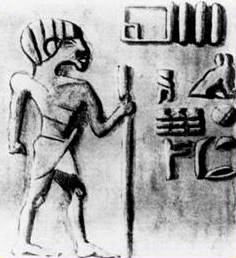 The people of the Nile Valley illustrated themselves in this manner on the so called Hieroglyphics, which is a Greek term, or Medu Netjer (Neter/Neder) the Afrikan word, which means the “writing of the gods”. Medu means “the word” and Netjer means “the spirit, force, or God”. Hieroglyphics therefore means the Holy writing or sacred writing. Higher writing is probably what the Greeks also meant by it, but the Afrikans meant the sacred text or sacred writing.
The people of the Nile Valley illustrated themselves in this manner on the so called Hieroglyphics, which is a Greek term, or Medu Netjer (Neter/Neder) the Afrikan word, which means the “writing of the gods”. Medu means “the word” and Netjer means “the spirit, force, or God”. Hieroglyphics therefore means the Holy writing or sacred writing. Higher writing is probably what the Greeks also meant by it, but the Afrikans meant the sacred text or sacred writing.
When these carvings and human images are shown, elements can be extracted that will give an understanding on the nature of these people. For example, just by analyzing the manner in which this man is dressed should provide a clue. “Who dresses that way in 110 degree temperature with the sun blazing down at high noon? Unless that individual is heavily pigmented, he will not be able to stand outside in the sunlight for any lengthy period of time without being harmed by the rays, but this is the typical form of dress for the Afrikan who even today can indeed stand in the sunlight and be dressed only in a wrap like this one. Take note of the little kilt or apron that is worn by this person which has now evolved into what is known as the Masonic apron.
That image is of Tera Neter who was one of the early kings before Egypt became a nation back in pre-dynastic history, when there were at least a thousand years of good civilization way before Egypt in that location. Bear in mind that the first date in human history which can be documented for the calendar is around 4,236 B.C., when the Afrikans in the Nile Valley already had a 365 day a year calendar that is still being used today. This date is therefore long before the 3,100 years B.C that Egypt starts, which indicates that there were a lot of high tech activities in existence long before the beginning of Egypt with people who resembled that in the image.
Egyptians referred to themselves by the word KM. On the hieroglyph in the underlined sentence to the left side there is something that looks like a little stair step which represents the hieroglyphic symbol or Medu Netjer, the symbol for KM. It is sitting over an object that looks like half a ball which represents the hieroglyph for T. From these symbols KMT (Kemet) is obtained with derivative words like chemistry, chemical, Kham and so forth, all coming from the same KMT root.
The following article is taken from the book, “UNESCO General History of Africa Vol. II, Ancient Civilizations of Africa”, The Egyptians as they saw themselves.
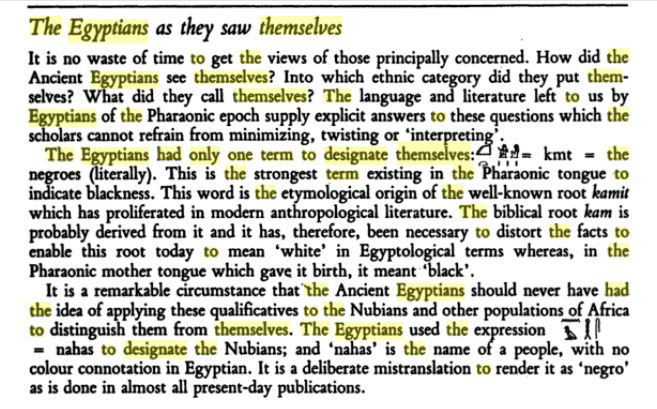
This is the strongest word in the Egyptian language meaning Black. In addition, there are two little people sitting beside the symbol which signifies that it is talking about Black People, although for some distorted reason others try to push forward the idea that it should mean the Black land only, which it could, but it really means the “Black people of the Black land”.
This is not only physical proof to show that the Egyptians were Black, but there is also the name by which the Egyptians called themselves, which means Black people.
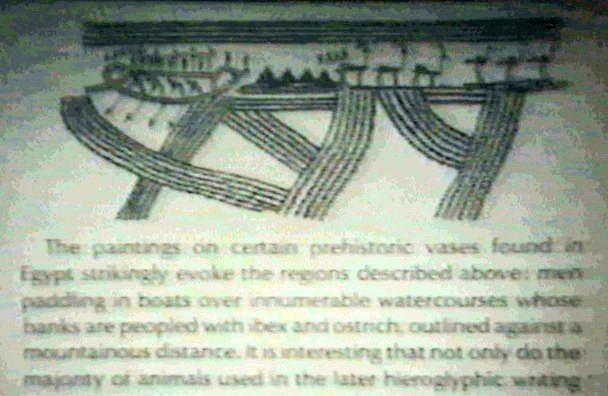 This is a picture the Egyptians drew of their homeland on some pottery. It is only a sketch and not the actual object of the items that appear on the pottery, which reveals that the ancient Egyptians recalled scenes from up the river. The animals in these pictures are found south of Egypt, so these are scenes recall their own cultural connections to the Afrikan interior.
This is a picture the Egyptians drew of their homeland on some pottery. It is only a sketch and not the actual object of the items that appear on the pottery, which reveals that the ancient Egyptians recalled scenes from up the river. The animals in these pictures are found south of Egypt, so these are scenes recall their own cultural connections to the Afrikan interior.
When the Aswan Dam was built some 400 miles south of Cairo, it began to flood almost all the country of Nubia. To view the Nile from the air, it would be observed that people resided 2 to 3 miles on either side, and beyond that point is the desert land. It is possible to almost stand anywhere up the river with one foot on the Black fertile land and the other on the red desert land.
Since the Nubians lived that close to the river it meant that anytime a dam is built nearby it would flood what would be the living land of a people. There is also a lake about 450 miles long which began to cover the homeland, that is, the habitable land, or all of the Black dirt where the Nubian population lived south of Egypt in the Sudan, leaving only the red dirt or sand, causing the Nubian people to be eventually moved and relocated. Many of them went to Egypt and now live there as Nubian citizens.
The important factor here is that before the lake covered the land, UNESCO and other western nations of the world contributed funds to help rescue articles like pottery, bones, artifacts, building structures and so on from being covered up, that could be used to help recreate the historical past of those people. The cemetery, which is the major place where bodies can be dug up to see what the people of the area looked like, were covered up.
So when the Aswan Dam was built, the chance to finish finding out the story of the Afrikans who were immediately south of Egypt in Nubian was destroyed since it is now under water and being covered with more and more mud coming from Southern Afrika each year.
Before the destruction took place, this sketch of an incense burner was published on the front page of the New York Times. It was done by rolling the wooden incense burner in clay so as to make an impression in order to see what the images on the sides of the incense burner were like. This is important because it helps to establish a date for Ta Seti, the nation south of Egypt which was older than Egypt.

On the incense burner there are three boat litters. The middle one illustrates a Pharaoh sitting with the crown of the south on his head with the flail in his hand, and a bird just over his right shoulder in a tree. This is the way the bird Horus which represented the God Horus is always depicted. This means that in Ta Seti 200 years before Egypt was even established, Horus, Osiris and Isis were already being worshipped by the people of Ta Seti as The first Holy family.
The bodies discovered of the people of Ta Seti are described as tall with full Negroid features by the people who dug them up. Not only do we have a nation south of Egypt, but we also have a physical description of the people who populated that nation, and a cultural description of what they were doing, which shows that the elements of government and religion that would be found later in Egypt were not native to Egypt but came from the south of Egypt where even Blacker people lived.
 In fact, “the Blackest people on the continent of Afrika, the really dark people appear mainly in that Nubian section of Afrika, with the blue tint”. Remember the song "We are the people darker than blue" by Curtis Mayfield. They were even proclaimed by the Greeks and Romans as the most beautiful people in the world, with Homer talking about them in glowing terms. Those were the same people who developed that civilization.
In fact, “the Blackest people on the continent of Afrika, the really dark people appear mainly in that Nubian section of Afrika, with the blue tint”. Remember the song "We are the people darker than blue" by Curtis Mayfield. They were even proclaimed by the Greeks and Romans as the most beautiful people in the world, with Homer talking about them in glowing terms. Those were the same people who developed that civilization.
Here is an image of one of them taken from one of the grave sites showing what they looked like when they either carved their God or their own people who still look like the people there.

 This is one of the combs that Afrikans used which should still look very familiar. Willie Morrow, a writer from San Diego, wrote a book entitled "400 Years Without A Comb." He was a barber, and what he was drawing attention to was the fact that Black people in America had been on the continent for 400 years, and during that time if a search had to conducted for an artefact that should have been in their possession it would have been discovered that they had lost their comb, and as a result began to cut their hair short. Black people did not know that there were appropriate instruments for the texture of Black hair such as the pick, which only came back into use during the 1960's, but Afrikans were still using it on their continent while other Black people outside of Afrika had lost the memory of what was appropriate for them, and resorted to using fine tooth combs and hair products like Brylcreem.
This is one of the combs that Afrikans used which should still look very familiar. Willie Morrow, a writer from San Diego, wrote a book entitled "400 Years Without A Comb." He was a barber, and what he was drawing attention to was the fact that Black people in America had been on the continent for 400 years, and during that time if a search had to conducted for an artefact that should have been in their possession it would have been discovered that they had lost their comb, and as a result began to cut their hair short. Black people did not know that there were appropriate instruments for the texture of Black hair such as the pick, which only came back into use during the 1960's, but Afrikans were still using it on their continent while other Black people outside of Afrika had lost the memory of what was appropriate for them, and resorted to using fine tooth combs and hair products like Brylcreem.
 The key point is that if it was so easy to forget a vital item like the pick, then it is also just as easy to lose the memory of one’s culture, and this is why it becomes necessary to go back and reconstruct the details of what our people did.
The key point is that if it was so easy to forget a vital item like the pick, then it is also just as easy to lose the memory of one’s culture, and this is why it becomes necessary to go back and reconstruct the details of what our people did.
Monotheism was created by the Afrikans who never knew anything other than monotheism, although there may have been different forms of monotheism. So contrary to popular beliefs, Black people were always worshippers of one God.
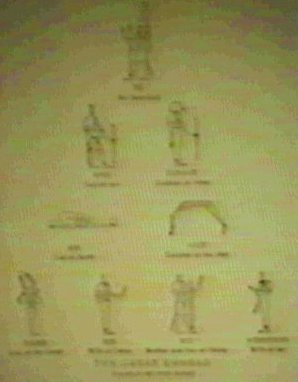 They also had different manifestations of God which confused the white missionaries who are incapable of thinking in abstract terms, who thought that every time a new name was called, the Afrikans were referring to a different God. For example, here is the great God Re (Ra) at the top who has two children, Shu and Tefnut but those are not gods but aspects of the one God, Shu being the air and Tefnut being the moisture. Also look at Geb who represents the earth and Nut who represents the sky.
They also had different manifestations of God which confused the white missionaries who are incapable of thinking in abstract terms, who thought that every time a new name was called, the Afrikans were referring to a different God. For example, here is the great God Re (Ra) at the top who has two children, Shu and Tefnut but those are not gods but aspects of the one God, Shu being the air and Tefnut being the moisture. Also look at Geb who represents the earth and Nut who represents the sky.
No one thinks of the sky as being God, but simply a manifestation of God. In other words, these features of the deity became identified as separate Deities in the minds of the people who came to Afrika, but the Afrikans never conceptualized it in that way. They always thought of these things as powers of the one God who was always the head, being “the unseen, unknown, unknowable” whose name could not even be spoken. In the south of Egypt that God was usually called Amon (Amen/Amun/Ammun). The Egyptians never had a name for Him, but the word Amon simply meant God who is hidden. It is from this very source that the word Amen was borrowed and uttered to this unknown God in many of the western religions. Our prayers end with Amen or Amon, which means “He who is hidden, but who though hidden, is the source of all life, power and health”.
Below is the God Min on the left and the goddess, or power, or aspect of God known as MAAT on the right. MAAT stands for Truth, Justice and Righteousness and has always been the primary or national Afrikan principle as opposed to other nations which are warlike and who have as their national principle, conquering the world, conquering eternity, conquering space and so on.
What the Afrikans wanted to achieve when they were doing the things they thought best was to live according to the highest principles of God made plain through MAAT, which means truth, justice and righteousness. There is probably no other nation in the history of human kind that has ever had a higher order of goals.
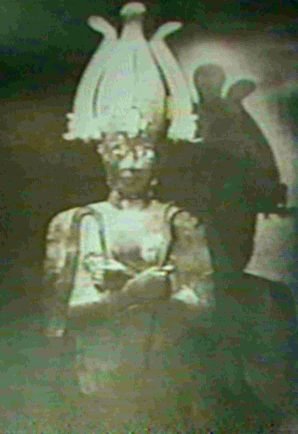
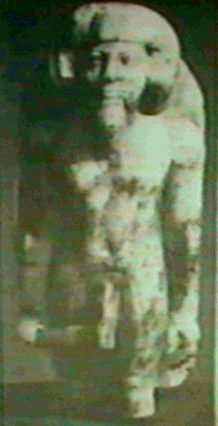 Here is another of the Deities on the left, who looks as if he is wearing an afro hair style. He is the pre-dynastic God Osiris who is always shown as the Black God, and also known as The Good Shepherd. This particular image of Osiris on the right was created in the old kingdom, but there are other images of Osiris that were created earlier than that, which show him as the Black God.
Here is another of the Deities on the left, who looks as if he is wearing an afro hair style. He is the pre-dynastic God Osiris who is always shown as the Black God, and also known as The Good Shepherd. This particular image of Osiris on the right was created in the old kingdom, but there are other images of Osiris that were created earlier than that, which show him as the Black God.
By the way, note that Osiris has a crook like the shepherd's crook in one hand and the flail in the other. He was known as the Good Shepherd which was the first time that God was referred to as the Good Shepherd.
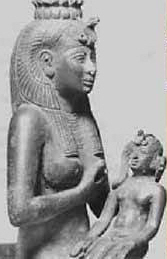 Osiris was married to Isis, “who was the first virgin mother in the world”. She had a son whose name was Heru or as the Greeks called him, Horus. So the son of God was born of a virgin and had the same qualities as God.
Osiris was married to Isis, “who was the first virgin mother in the world”. She had a son whose name was Heru or as the Greeks called him, Horus. So the son of God was born of a virgin and had the same qualities as God.
The Greeks transposed all these Afrikan names, because Osiris is really the Greek word but his Afrikan name is Ausar (Asar/Asa) and his wife's name is Auset (Aset/Ast), but the Greeks called her Isis. Heru is her son's name but the Greeks named him Horus. As a result of these name changes, the original meanings often become lost.
This was the First Holy Family in human history which is currently imitated or at least there is a strange resemblance between this holy family and the Christian holy family, where you have God the Father, the virgin mother and the Son of God in Christ. In any case, this model was already present in Afrika at the beginning of Egyptian (Kemetic) civilization.
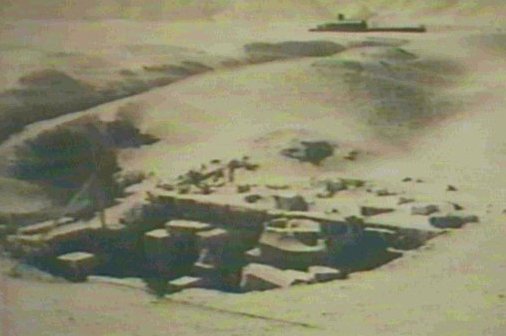 By the way, the God Asar was crucified and his body was split into parts and buried all over Egypt. His head was supposed to be buried at Abdju which the Greeks called Abydos. Therefore “Asar was the first crucified saviour”. His wife collected all the parts together and dedicated sites for them which became the source of the world's first passion play.
By the way, the God Asar was crucified and his body was split into parts and buried all over Egypt. His head was supposed to be buried at Abdju which the Greeks called Abydos. Therefore “Asar was the first crucified saviour”. His wife collected all the parts together and dedicated sites for them which became the source of the world's first passion play.
At Easter when there were passion plays, pilgrims would come from all over the world and go to the grave of Osiris in Abdju (Abydos) to act out the death, burial, and resurrection of Asar (Osiris). This site which used to be called The Holy Land still exists today, but there are now other places that are called The Holy Land.
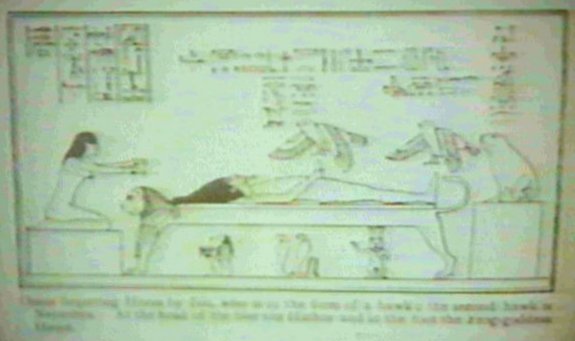
 On the right is another picture of Ausar/Asar (Osiris) who is shown this time in human form as a pigmy. This is the way he is shown in the sacred text whenever the Afrikans sketched him. To the left is the first picture or drawing of The Immaculate Conception, where Asar/Asa (Osiris) is seen lying down with his phallus erect. The bird hovering over the phallus is that of Ast/Auset/Aset (Isis) who is being impregnated by Asar, after which the son of Asar will be born from this virgin mother. Below is the actual picture of The Immaculate Conception as it appeared on the wall of the temple of Seti I in Abdju but it is difficult to see.
On the right is another picture of Ausar/Asar (Osiris) who is shown this time in human form as a pigmy. This is the way he is shown in the sacred text whenever the Afrikans sketched him. To the left is the first picture or drawing of The Immaculate Conception, where Asar/Asa (Osiris) is seen lying down with his phallus erect. The bird hovering over the phallus is that of Ast/Auset/Aset (Isis) who is being impregnated by Asar, after which the son of Asar will be born from this virgin mother. Below is the actual picture of The Immaculate Conception as it appeared on the wall of the temple of Seti I in Abdju but it is difficult to see.
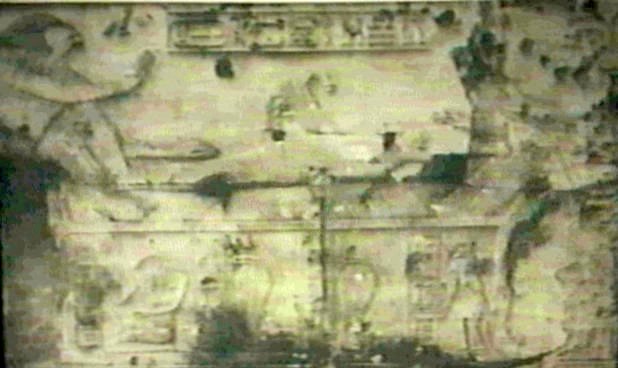
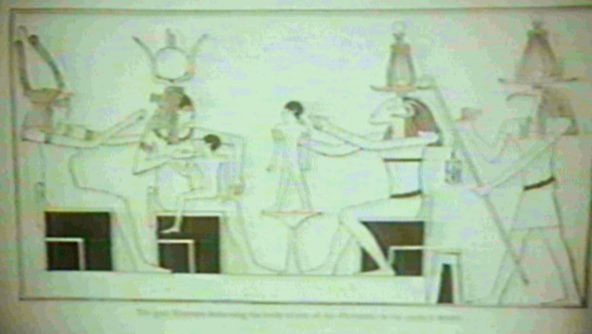 This is Khnum, another aspect of God which the Afrikans had of God who is being portrayed as the creator. He has a human body and a ram's head and is seen making a man on his potter's wheel.
This is Khnum, another aspect of God which the Afrikans had of God who is being portrayed as the creator. He has a human body and a ram's head and is seen making a man on his potter's wheel.
The image that we visualize in the old spiritual "thou art the potter, I am the clay, make me and mould me after thy will", can be found on the walls of temples up and down the Nile. That is the Afrikan’s conception of God as the creator.

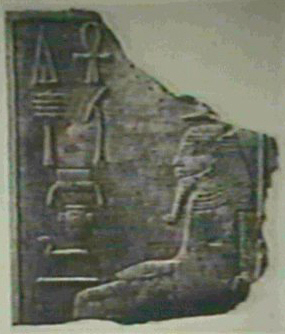 At Memphis, the name of God was Ptah, (left) the Supreme Being or the One God. At Abdju (Abydos) they called Him Amon (Amun/ Amen), while at other places he may have been known by different names but they all referred to the one and only Deity.
At Memphis, the name of God was Ptah, (left) the Supreme Being or the One God. At Abdju (Abydos) they called Him Amon (Amun/ Amen), while at other places he may have been known by different names but they all referred to the one and only Deity.
Their images are being shown so it is clear that they are not unlike the Afrikans who still live there today. On the right is the God Geb. What is being pointed out here is that all of these images are Afrikan in nature and they appear in the first 1,000 years before any foreign invasions.
That is why it is so important to have the dates correct, because at the point when you begin to see images of Egyptians who look European, we are not talking about the old kingdom, we are not talking about the pyramid age, we are not talking about the temple age, we are talking about The Greco-Roman period, we are talking about the time after everything had already been created.
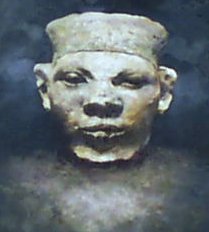 Here is the first president of Egypt. His name is Mina or Menes as called by the Egyptians, or Minos as called by the Greeks. In the 1st dynasty or 5,700 years B.C. it is recorded that Menes brought the first world government to the world by uniting what was known as Upper and Lower Egypt, and establishing a capital called Menefer which the Greeks called Memphis. This has been documented by the last African priest named Mer-en-Jehuti whom the Greeks renamed Manetho.
Here is the first president of Egypt. His name is Mina or Menes as called by the Egyptians, or Minos as called by the Greeks. In the 1st dynasty or 5,700 years B.C. it is recorded that Menes brought the first world government to the world by uniting what was known as Upper and Lower Egypt, and establishing a capital called Menefer which the Greeks called Memphis. This has been documented by the last African priest named Mer-en-Jehuti whom the Greeks renamed Manetho.
Menes also started hydraulic engineering, but Black students who enter college to pursue engineering are never taught anything about this Afrikan which would be an inspiration to every Black youth. The important thing to note is that he also came from the south, in other words, whenever there was a high tech civilization in Egypt, the leader usually came from the south.
What is needed in order to get the story of Egypt correct is a calendar similar to the one that exists of U.S. presidents starting with George Washington. Anyone looking at such a calendar with the presidential faces of America would know that the country had been run by white males the whole time it has been here, so a lecture on it would not be necessary. Now if there were a calendar of Egyptian Pharaonic faces from the earliest time right up to the present, there would be no need for a study like this either.
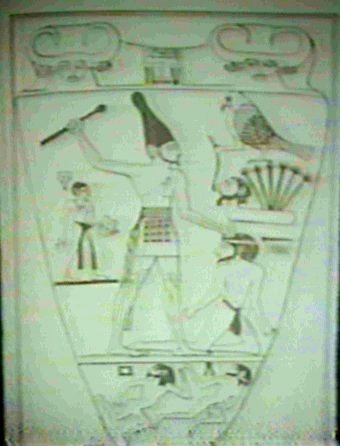
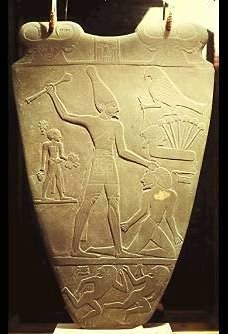 On the left is a sketch of an artist's palace showing the king knocking his enemies over the head with his mace. On the right is the picture of the actual object for comparison.
On the left is a sketch of an artist's palace showing the king knocking his enemies over the head with his mace. On the right is the picture of the actual object for comparison.
This activity, by the way, is now being imitated every year at graduation ceremonies where the professor carries a mace, but this idea of a mace was already present some 3,100 years ago B.C., which has influenced the idea of the mace as a symbol of authority and responsibility.
Here are more images of the God Amon/Amun/Amen as displayed in the Egizio Museum – Turin.
Below are additional images of the early Pharaohs who were from the first, second and third dynasties which provide a glimpse of what their carvings looked like, but later their actual mummies will be shown.


©John Moore - Barbados, W.I. (March 2000)©. All rights reserved.